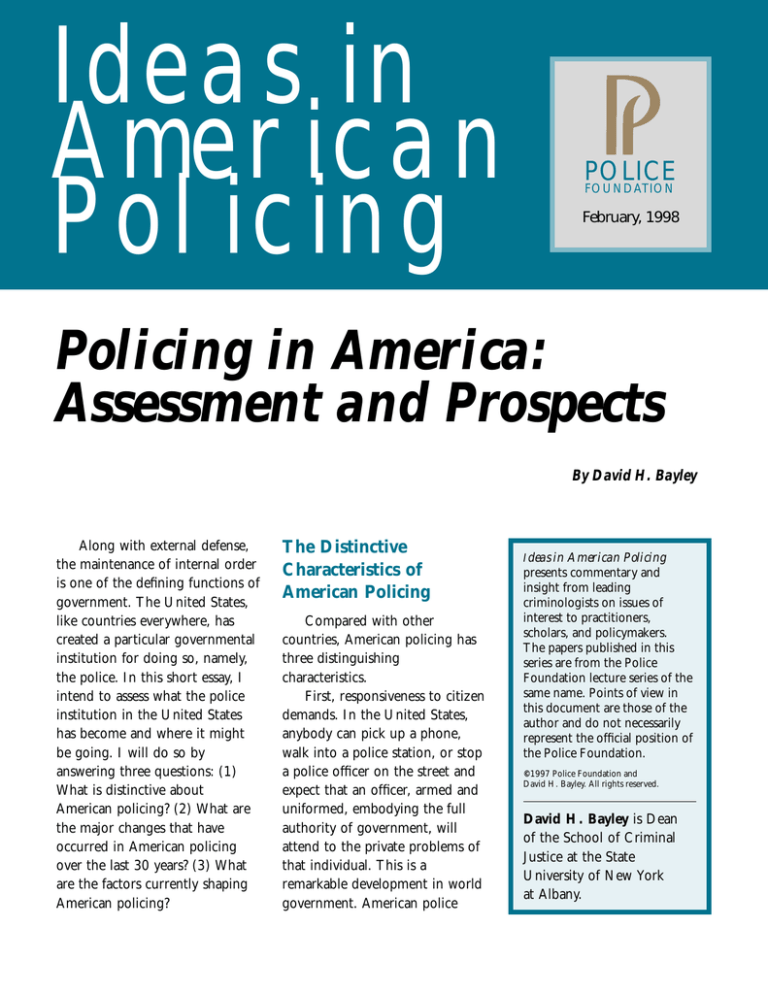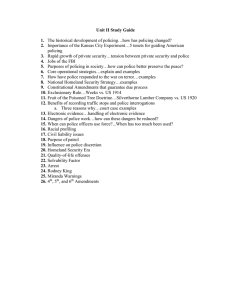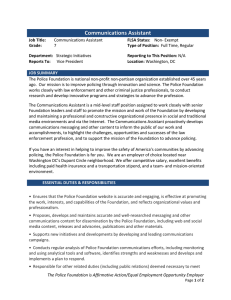
Ideas in
American
Policing
POLICE
FOUNDATION
February, 1998
Policing in America:
Assessment and Prospects
By David H. Bayley
Along with external defense,
the maintenance of internal order
is one of the defining functions of
government. The United States,
like countries everywhere, has
created a particular governmental
institution for doing so, namely,
the police. In this short essay, I
intend to assess what the police
institution in the United States
has become and where it might
be going. I will do so by
answering three questions: (1)
What is distinctive about
American policing? (2) What are
the major changes that have
occurred in American policing
over the last 30 years? (3) What
are the factors currently shaping
American policing?
The Distinctive
Characteristics of
American Policing
Compared with other
countries, American policing has
three distinguishing
characteristics.
First, responsiveness to citizen
demands. In the United States,
anybody can pick up a phone,
walk into a police station, or stop
a police officer on the street and
expect that an officer, armed and
uniformed, embodying the full
authority of government, will
attend to the private problems of
that individual. This is a
remarkable development in world
government. American police
Ideas in American Policing
presents commentary and
insight from leading
criminologists on issues of
interest to practitioners,
scholars, and policymakers.
The papers published in this
series are from the Police
Foundation lecture series of the
same name. Points of view in
this document are those of the
author and do not necessarily
represent the official position of
the Police Foundation.
©1997 Police Foundation and
David H. Bayley. All rights reserved.
David H. Bayley is Dean
of the School of Criminal
Justice at the State
University of New York
at Albany.
operations—the work that police
do—are determined overwhelmingly by requests from
individual citizens. In many other
countries, and in almost all
countries historically, police were
created by governments to
safeguard the interests of regimes.
Police in the United States today,
and in a handful of other stable
democratic countries, go to great
lengths to respond to what
individuals want. It has become
fashionable in writing about the
police to complain about the
demands that the 911 system
places on police. However
justified the criticism may be
from the point of view of
workload, the political instincts of
American police to remain
responsive to individual requests
for service are surely correct and
should be encouraged.
Second, public accountability.
The United States insists on
making the police accountable
through multiple institutions—
elected politicians, criminal and
civil courts, the press, and civilian
review of complaints. This is rare
in a world where the press is
often censored by government,
police misdeeds are subject only
to the invisible discipline of the
police themselves, and politicians
rely on the police to keep
themselves in power.
Third, openness to evaluation.
American police believe that
policy must be based on accurate
factual information. This is partly
a matter of managerial culture,
where a “show-me” mentality
predominates. Senior officers are
uncomfortable merely following
tradition; they want programs to
be demonstrably cost effective.
American policing is also uniquely
open to examination by people
outside the police. Scholars,
management consultants,
politicians, and members of the
community with a serious interest
in policing can get access to
almost any activity of any police
I think there have been
seven great changes in
American policing during
what amounts to my
working lifetime.
——
2
——
force. Only a handful of other
countries in the world can make
this claim. Indeed, my private test
for democraticness is whether a
foreign government will give me
a visa to study their police. I
submit that this is not a trivial
test and that the United States
passes with flying colors.
Judging the contemporary
American police by international
as well as historical standards,
there is much to be proud of.
This is easy to forget, especially
among those of us who study the
police for a living. Our stock-intrade, after all, involves pointing
out where the police can do
better and, hopefully, show them
how. But we must never forget
that compared with other
countries, there is a healthy baby
in the police bath water.
Significant Changes in
the American Police
The appointment of the
President’s Commission on Law
Enforcement and the Administration of Justice (1966) marks
the beginning of what is generally
considered to have been a period
of great change in American
policing. What in fact are the
accomplishments of the past
30 years, and to what extent
have they contributed to the
distinctiveness of contemporary
American policing? I think there
have been seven great changes in
American policing during what
amounts to my working lifetime.
(1) The intellectual caliber of
the police has risen dramatically.
American police today at all ranks
are smarter, better informed, and
more sophisticated than police in
the 1960s.
(2) Senior police managers
are more ambitious for their
organizations than they used to
be. Chiefs and their deputies are
no longer content to tend
someone else’s store; they want
to leave their own distinctive
stamp on their organizations. To
do this, they now recognize that
management is an important
specialized skill that must be
developed.
(3) During the last 30 years,
an explicit scientific mindset has
taken hold in American policing
that involves an appreciation of
the importance of evaluation and
the timely availability of
information.
(4) The standards of police
conduct have risen. Despite
recent well-publicized incidents
of brutality and corruption, I
believe that American police
today treat the public more fairly,
more equitably, and less venally
than police did 30 years ago.
(5) Police are remarkably
more diverse in terms of race and
gender than a generation ago.
This amounts to a revolution in
American policing, changing both
its appearance and, more slowly,
its behavior.
(6) The work of the police
has become intellectually more
demanding, requiring an array of
new specialized knowledge about
I am not convinced that
strategic changes have been
widespread, nor that what
is commonly accepted as
new is in fact new at all.
technology, forensic analysis, and
crime. This has had profound
effects on recruitment, notably
civilianization, organizational
structure, career patterns, and
operational coordination.
(7) Civilian review of police
discipline, once considered
anathema, has gradually become
accepted by police. Although the
struggle is not yet over, I believe
that expansion is inevitable as
more and more senior police
executives see that civilian review
reassures the public and validates
their own favorable opinion of
the overall quality of police
performance. This revolution has
already taken place in Australia,
Britain, and Canada, and Sam
Walker’s recent work convinces
me that the corner has been
turned in the United States
(Walker and Bumpus 1991).
This, then, is my list of the
most significant changes that have
occurred in American policing
——
3
——
over the past 30 years. It may
surprise and even astonish many
readers that I have not
mentioned changes in the
strategies of policing, especially
the advent of community
policing. I have not done so
because I am not convinced that
strategic changes have been
widespread, nor that what is
commonly accepted as new is in
fact new at all.
I do not mean to suggest that
genuine innovation is not going
on. Wherever I go, I am
enormously impressed with the
strategic creativity of American
police. Smart people are doing
smart things. But what they are
doing is so diverse that it is hard
to describe. For example, Edward
Maguire and his colleagues
needed 31 separate categories to
capture activities that are
associated with community
policing (Maguire et al. 1997)
Robert Worden and I used 11
programmatic indicators for
community policing in our recent
survey (forthcoming). When one
adds “quality-of-life” enforcement
programs as well as problemspecific tactics to the list, strategic
inventiveness becomes too
complex to capture in the
fashionable notions of
community- or problem-oriented
policing.
Moreover, the most common
innovations—DARE, crimeprevention programs, and beat
cops—vary enormously in their
quality and, even when done
well, are arguably not particularly
new.
Altogether, then, American
police should be congratulated
for trying new things, but exactly
what their strategic
inventiveness consists of is hard
to say. COP and POP have
been wonderful philosophic
sticks for encouraging the
police to reexamine customary
strategies, but they are awkward
descriptive terms for what has
been taking place. Proponents
of community policing, among
whom I count myself, are
somewhat like the beaver in a
cartoon I saw some time ago.
The beaver is talking
to a rabbit at the base of the
enormous concrete face of
Grand Coulee dam and says,
“I wouldn’t want you to think
I built this, but it is based on
an idea of mine.” The amount
of strategic inventiveness in
One implication of this
observation about strategic
change in American
policing is that research
may not have made as
significant, or at least as
coherent, an impression
on policing as scholars like
to think.
——
4
——
American policing can be
counted as a major change over
the past 30 years. What is
specifically new substantively is
difficult to pinpoint.
American Police and
Scholarly Research
One implication of this
observation about strategic
change in American policing is
that research may not have made
as significant, or at least as
coherent, an impression on
policing as scholars like to think.
Indeed, the fortunes of police
research have been mixed and
perplexing. The two studies that
challenged the traditional core
strategies most directly, namely,
the Kansas City Preventive Patrol
Experiment (Kelling et al. 1974)
and Greenwood-ChaikenPetersilia’s examination of the
criminal investigation process
(1976), have had a curious
history. The findings of both are
accepted as being true, even
though their research designs
have been sharply criticized, their
impact on police practice has
been very small, and neither has
been replicated. With respect to
the efficacy of patrol, the nearest
one comes to replication is from
“hot spots” analysis (Sherman
et al. 1989), and with respect to
criminal investigation, the
research of John Eck (1982) and
the British Royal Commission on
Criminal Procedure (1981).
Perhaps Kansas City and
Greenwood-Chaiken-Petersilia
have not been replicated because
they confirmed the obvious. But
if that is the case, then why
hasn’t their impact on operations
been greater?
Two other studies, however,
have made a major impact on
police policy and both have been
replicated—the efficacy of rapid
response and police tactics in
cases of misdemeanor spousal
assault. The irony here is that we
now wish the second study
(Sherman and Berk 1984) had
not had so dramatic an impact on
police operations.
Although this review of police
research is hardly exhaustive, it
seems to me that the connection
between policy research and
policy is not close. Indeed, it is
often paradoxical in that criticism
has not led regularly to
replication, even when the
research was flawed and the
implications for policy were very
great. Nor has research led to
widespread operational changes
even when it has been accepted
as true.
Factors Shaping
American Policing
Unhappily for my scholarly
self-esteem, I am beginning to
suspect that the future of
American policing will not be
shaped by research or strategic
planning. The role, function, and
strategies of police are more likely
to reflect the impact of forces
that are unseen by either scholars
or police practitioners. Based on
The role, function, and
strategies of police are more
likely to reflect the impact
of forces that are unseen by
either scholars or police
practitioners.
the historical record, I believe
that the future of American
policing will be shaped most
profoundly by four factors.
First, privatization, meaning
the loss of market share by the
public police in providing defense
against crime. There is a growing
dualism in policing in all
developed nations, with the
public police providing security
for the poor and private police
providing security for the rich
(Bayley and Shearing 1996).
There is the additional threat that
as the affluent classes learn to rely
more on private police, they will
become less willing to be taxed
to provide policing for the poor.
Just such a withdrawal of support
seems to be happening with
respect to public education.
Alternatively, the affluent classes
might continue to support public
policing, but only on the
condition that its approach to
——
5
——
crime prevention among the poor
emphasizes deterrence rather than
the service approach characteristic
of community policing.
Second, restructuring of
government. A momentous
debate is occurring in American
politics over the content and
appropriate location of
governmental action. To what
extent should government
supplant or regulate market
forces, especially in providing
social services, and which levels of
government should be
responsible for administering
programs, the so-called
“devolution revolution.” This
debate has been reflected directly
in policing through communityand problem-oriented policing.
COP/POP call for changes in
both the content and location of
policing. Under its philosophy,
police functions expand as police
develop partnerships with
The development of police
research during the last
30 years has institutionalized the practice of
critical reflection within
American policing.
communities, and decisionmaking
becomes more decentralized.
COP/POP is politically
contradictory—more liberal with
respect to police functions, more
conservative with respect to the
location of authority.
Third, group violence
stemming from the inequities of
race, class, and ethnicity. Every
large police force is concerned
about the threat of mass violence,
especially in large cities. As Kraska
and Kappeler have shown (1997),
many police forces have already
moved quietly to prepare for it.
Group violence shapes policing
more profoundly than any other
single factor (Bayley 1975,
1985). If group violence in the
United States becomes persistent
or widespread, COP/POP will be
dead in the water and the quasimilitary character of policing, so
often deplored, will intensify.
Fourth, growth in the
destructiveness of criminal
violence, especially with regard to
terrorism and organized crime. I
don’t believe that people are
becoming more violent and
bloodyminded than they have
always been. But technology has
raised the potential
destructiveness of criminal
actions. Like group violence, this
too will encourage a warfare
mindset among police, where
crime prevention become
clandestine and enforcement
oriented rather than public and
ameliorative.
Conclusion
Having argued that research
has had only a small impact on
the strategies of policing and that
our ability to foresee and plan for
the future is probably limited,
one might conclude that I believe
research on the police is only
marginally important. That is not
my view. Research on the police
——
6
——
is essential, but its impact is
different from what many
scholars think. Scholars cannot
claim credit for major strategic
changes, but they can claim credit
for reinforcing the unique
institutional ethos of the
American police, which
incorporates fact-based
evaluation, openness to
observation, and responsiveness
to diverse opinions. The influence
of scholarship on policing is
indirect rather than direct. Its
value should not be judged in
narrow operational terms. The
development of police research
during the last 30 years has
institutionalized the practice of
critical reflection within American
policing. In so doing, it has
deepened the most distinctive
aspects of American policing—its
responsiveness and accountability.
This is no small accomplishment.
Bibliography
Bayley, David H. 1975. The police
and political development in
Europe. In The formation of
national states in western Europe.
ed. Charles Tilly. Princeton, NJ:
Princeton University Press.
_____. 1985. Patterns of Policing.
New Brunswick, NJ: Rutgers
University Press.
Bayley, David H., and Clifford
Shearing. 1996. The future of
the police. Law and Society
Review.
Bayley, David H., and Robert
Worden. Forthcoming. Federal
funding of police overtime: A
utilization study. Washington,
DC: National Institute of
Justice.
Eck, John E. 1982. Solving crimes:
The investigation of burglary and
robbery. Washington, DC: Police
Executive Research Forum.
Greenwood, Peter W., Jan M.
Chaiken, and Joan Petersilia.
1976. The criminal investigation
process. Washington, DC: US
Government Printing Office.
Kelling, George L., Tony Pate,
Duane Dieckman, and
Charles E. Brown. 1974. The
Kansas City preventive patrol
experiment: A summary report.
Washington, DC: Police
Foundation.
Kraska, Peter B., and Victor E.
Kappeler. Militarizing American
police: The rise and normalization of paramilitary units.
Social Problems 44 (1): 1–18.
Maguire, Edward R., Joseph B.
Kuhns, Craig D. Uchida, and
Stephen M. Cox. 1997. Patterns
of community policing in
nonurban America. Journal of
Research in Crime and
Delinquency 34:368–94.
President’s Commission on Law
Enforcement and Administration
——
7
——
of Justice. 1967. The challenge of
crime in a free society.
Washington, DC: US
Government Printing Office.
Royal Commission on Criminal
Procedures. 1981. Research
Study 17. London: Her Majesty’s
Stationary Office.
Sherman, Lawrence W., and
Richard A. Berk. 1984. The
specific deterrent effects of arrest
for domestic assault. American
Sociological Review 49 (2): 261–
72.
Sherman, Lawrence W., Patrick R.
Gartin, and Michael E. Buerger.
1989. Hot spots of predatory
crime: Routine activities and the
criminology of place.
Criminology 27 (1): 27–55.
Walker, Samuel, and Vic W. Bumpus.
1991. Civilian review of the
police: A national survey of the 50
largest cities. Omaha: University
of Nebraska Press.
ABOUT THE
POLICE FOUNDATION
The Police Foundation is a private,
independent, not-for-profit organization
dedicated to supporting innovation and
improvement in policing through its research,
technical assistance, and communications
programs. Established in 1970, the
foundation has conducted seminal research
in police behavior, policy, and procedure,
and works to transfer to local agencies the
best new information about practices for
dealing effectively with a range of important
police operational and administrative
concerns. Motivating all of the foundation’s
efforts is the goal of efficient, humane
policing that operates within the framework
of democratic principles and the highest
ideals of the nation.
BOARD OF DIRECTORS
Chairman
William H. Webster
President
Hubert Williams
Dr. Freda Adler
Dr. Lee P. Brown
Richard A. Grasso
OFFICE OF RESEARCH
William H. Hudnut III
David Weisburd, PhD
Senior Research Scientist
Dr. W. Walter Menninger
Rosann Greenspan, PhD
Research Director
David G. Olson, PhD
Senior Research Associate
Victor H. Palmieri
Edwin E. Hamilton, MA
Senior Research Analyst
Stanley K. Sheinbaum
Kellie Ann Bryant, MS
Research Associate
Alfred A. Slocum, Esq.
Justin Ready, MA
Research Associate
Sally Suchil, Esq.
Michael Clifton, MA
Research Assistant
Rachel Dadusc, BA
Administrative Assistant
POLICE
FOUNDATION
1201 Connecticut Avenue, NW, Washington, DC 20036
(202) 833-1460 • Fax: (202) 659-9149 • e-mail: pfinfo@policefoundation.org







